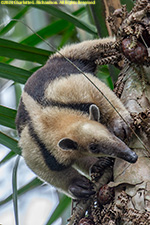 Northern Tamandua, Tamandua mexicana
Northern Tamandua, Tamandua mexicanaBocas del Toro consists of six densely forested islands, many uninhabited islets, and Panama's oldest marine park, Parque Nacional Marino Isla Bastimentos. Bocas del Toro was visited by Christopher Columbus on his fourth and final voyage in 1502. The area has vast banana plantations.
We based ourselves at Tranquilo Bay, the oldest and most remote resort on Bastimentos Island for bird and wildlife photography on the Caribbean side of Panama's westernmost province. The lodge has a 63' bird-watching tower and trained naturalist guides.
Wildlife:
Mammals:
Anteaters: The lesser anteater uses its claws to rip open ant and termite nests for food.
 Northern Tamandua, Tamandua mexicana
Northern Tamandua, Tamandua mexicana
Bats: The greater sac-winged bat is the most common bat seen in the rainforest. They are native to Central and South America.
 Great white-lined (greater sac-winged) bat, Saccopteryx bilineata
Great white-lined (greater sac-winged) bat, Saccopteryx bilineata
 Jamaican fruit-eating bat, Artibeus jamaicensis (or possibly Seba's short-tailed bat, Carollia perspilillata)
Jamaican fruit-eating bat, Artibeus jamaicensis (or possibly Seba's short-tailed bat, Carollia perspilillata)
Monkeys: Capuchins are common, easily observable and dexterous, making and using tools for defense and to get food.




 Panamanian white-faced capuchin, Cebus imitator
Panamanian white-faced capuchin, Cebus imitator
Opossums: The Central American Woolly Opossum is found in deiduous and moist evergreen forests of Central America.
 Central American (Derby's) Woolly Opossum, Caluromys derbianus
Central American (Derby's) Woolly Opossum, Caluromys derbianus
Sloths: Three-toed sloths have a short stubby tail and a raccoon-like face mask. Two-toed sloths, which also have three toes on their hind feet, have no tail and no mask. Both eat mainly leaves.




 Brown-throated three-toed sloth, Bradypus variegatus
Brown-throated three-toed sloth, Bradypus variegatus


 Hoffmann's two-toed sloth, Choloepus hoffmanni
Hoffmann's two-toed sloth, Choloepus hoffmanni
Squirrels: The Alfaro's Pygmy Squirrel is a small tree squirrel native to Central American rainforests.
 Alfaro's Pygmy (Central Americam Dwarf) Squirrel, Microsciurus alfari
Alfaro's Pygmy (Central Americam Dwarf) Squirrel, Microsciurus alfari
Reptiles:
Basilisks, especially young ones, can run on water. These diurnally active lizards sleep in trees overhanging water.

 Striped (brown) basilisk (male left, female right), Basiliscus vittatus
Striped (brown) basilisk (male left, female right), Basiliscus vittatus

 Green basilisk (male left, female right), Basiliscus plumifrons
Green basilisk (male left, female right), Basiliscus plumifrons
Caimans: This crocodilian is brownish, greenish, or yellowish-grey with a spectacle-like ridge between its eyes.
 Spectacled (white, common, speckled) caiman, Caiman crocodilus
Spectacled (white, common, speckled) caiman, Caiman crocodilus
Iguanas are large, arboreal, mostly herbivorous lizards.

 Green (American, common green) iguana, Iguana iguana
Green (American, common green) iguana, Iguana iguana
Lizards: Anoles are green or brownish lizards native to the warmer parts of the Americas.
 Cryptic slender anole, Anolis cryptilimifrons
Cryptic slender anole, Anolis cryptilimifrons
 Ground (humble) anole, Anolis humilis
Ground (humble) anole, Anolis humilis
Snakes: This nonvenomous snake is native to the New World. It often eats bird eggs. They change colors as they age.
 Bird-eating (puffing, bird) snake, Phrynonax poecilonotus
Bird-eating (puffing, bird) snake, Phrynonax poecilonotus
Insects:
Butterflies:
 Illioneus giant owl (Dusky owl butterfly), Caligo illioneus
Illioneus giant owl (Dusky owl butterfly), Caligo illioneus

 Mylotes (Arcas, pink-checked, true) cattleheart, Parides eurimedes
Mylotes (Arcas, pink-checked, true) cattleheart, Parides eurimedes
Caterpillars:
 Frangipani hornworm, Pseudosphinx tetrio
Frangipani hornworm, Pseudosphinx tetrio
Katydids:
Termites:
 Nasutitermes sp. <species TBS>
Nasutitermes sp. <species TBS>
Wasps:
Amphibians:
Frogs and toads:
 Rainforest rocket frog, Silverstoneia flotator (identification tentative)
Rainforest rocket frog, Silverstoneia flotator (identification tentative)
 Green and black poison dart frog, Dendrobates auratus
Green and black poison dart frog, Dendrobates auratus

 Strawberry poison dart frog, Oophaga pumillo
Strawberry poison dart frog, Oophaga pumillo
 Green climbing (evergreen) toad, Incilius coniferus
Green climbing (evergreen) toad, Incilius coniferus
Birds:
Other animals:
Crabs:
Slugs:
Spiders:



 Golden silk orb-weaver (banana) spider (females left, male right), Trichonephilia clavipes
Golden silk orb-weaver (banana) spider (females left, male right), Trichonephilia clavipes
©2024 Mermaid Underwater Photographic. All Rights Reserved.
Contact us at mermaid@underwater.org.
Last modified 26 March 2024